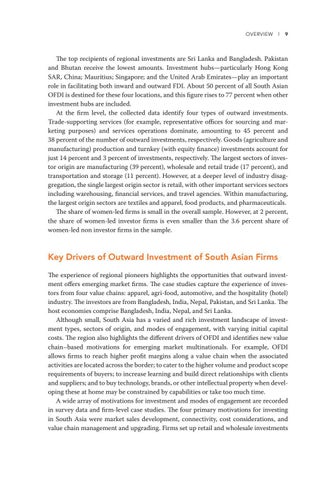OVERVIEW l 9
The top recipients of regional investments are Sri Lanka and Bangladesh. Pakistan and Bhutan receive the lowest amounts. Investment hubs—particularly Hong Kong SAR, China; Mauritius; Singapore; and the United Arab Emirates—play an important role in facilitating both inward and outward FDI. About 50 percent of all South Asian OFDI is destined for these four locations, and this figure rises to 77 percent when other investment hubs are included. At the firm level, the collected data identify four types of outward investments. Trade-supporting services (for example, representative offices for sourcing and marketing purposes) and services operations dominate, amounting to 45 percent and 38 percent of the number of outward investments, respectively. Goods (agriculture and manufacturing) production and turnkey (with equity finance) investments account for just 14 percent and 3 percent of investments, respectively. The largest sectors of investor origin are manufacturing (39 percent), wholesale and retail trade (17 percent), and transportation and storage (11 percent). However, at a deeper level of industry disaggregation, the single largest origin sector is retail, with other important services sectors including warehousing, financial services, and travel agencies. Within manufacturing, the largest origin sectors are textiles and apparel, food products, and pharmaceuticals. The share of women-led firms is small in the overall sample. However, at 2 percent, the share of women-led investor firms is even smaller than the 3.6 percent share of women-led non investor firms in the sample.
Key Drivers of Outward Investment of South Asian Firms The experience of regional pioneers highlights the opportunities that outward investment offers emerging market firms. The case studies capture the experience of investors from four value chains: apparel, agri-food, automotive, and the hospitality (hotel) industry. The investors are from Bangladesh, India, Nepal, Pakistan, and Sri Lanka. The host economies comprise Bangladesh, India, Nepal, and Sri Lanka. Although small, South Asia has a varied and rich investment landscape of investment types, sectors of origin, and modes of engagement, with varying initial capital costs. The region also highlights the different drivers of OFDI and identifies new value chain–based motivations for emerging market multinationals. For example, OFDI allows firms to reach higher profit margins along a value chain when the associated activities are located across the border; to cater to the higher volume and product scope requirements of buyers; to increase learning and build direct relationships with clients and suppliers; and to buy technology, brands, or other intellectual property when developing these at home may be constrained by capabilities or take too much time. A wide array of motivations for investment and modes of engagement are recorded in survey data and firm-level case studies. The four primary motivations for investing in South Asia were market sales development, connectivity, cost considerations, and value chain management and upgrading. Firms set up retail and wholesale investments

